Silverfish and Firebrats
ID
ENTO-24NP (ENTO-537NP)
Introduction
Silverfish (Order Zygentoma) are primitive insects often found in association with human residences and buildings. The firebrat (Thermobia domestica) is a species of silverfish that prefers warmer temperatures than other silverfish.
Description
Silverfish, including firebrats, are soft, flattened insects measuring approximately 0.5-1 inch long (13-25 mm). Many species of silverfish are covered with silvery gray scales (Fig. 1), although others are a darker gray, tan, or have mottled brown markings (Fig. 2). The bodies of silverfish and firebrats are broader at the head and taper towards the tip of the abdomen. They have long antennae and three long filaments extending outward from the tip of the abdomen (Fig. 1-3). Neither silverfish or firebrats have wings. Firebrats have bristly, somewhat stocky bodies with tan and dark brown markings (Fig. 3).
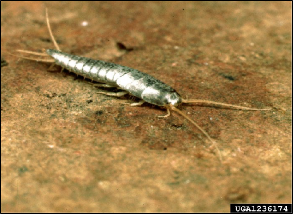
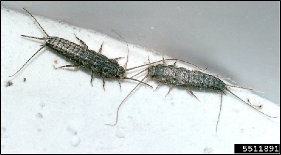
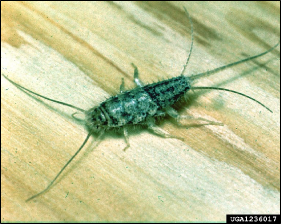
Habitat
Silverfish and firebrats are cosmopolitan insects found worldwide. Both insects require humidity to survive, but firebrats prefer higher temperatures of 86°F or higher (>30°C). In buildings, firebrats are often found near boilers, furnaces, hot pipes, and other heated areas while silverfish are commonly seen in attics, basements, garages, bathrooms, and other areas with lower temperatures. Both silverfish and firebrats are nocturnal insects that avoid light and run swiftly. Homeowners may not be aware of the presence of these pests until one is found trapped in the bathtub or sink. Outdoors these insects live under rocks and bark; in leaf litter; in caves; or in the nests of birds, mammals, and sometimes the colonies of other insects.
Life History
Silverfish have an incomplete life cycle of egg, nymphal, and adult stages. Adult female silverfish lay small eggs in cracks and crevices in batches of up to 50 eggs at a time. Females normally lay fewer than 100 eggs during a lifespan of 2-8 years. Under ideal conditions, eggs hatch in two weeks but can take much longer. The young nymphs look very much like the adults, only smaller. They take several years to reach sexual maturity and may live for several years. Unlike many insects, they continue to molt throughout their lifespan and must mate after each molt to produce viable eggs. Populations of silverfish do not build up rapidly because of the small number of eggs produced by each female and their slow development rate. A large infestation of silverfish usually means a building has been infested awhile.
Female firebrats lay eggs only when the temperatures are above 90° F (32° C). Nymphs cannot survive temperatures below freezing or above 112° F (44° C). A female firebrat usually lays fewer than 100 eggs in her lifespan of 1-1.5 years. Unlike other silverfish, firebrats can develop from egg to sexually mature adult in 11-12 weeks under ideal conditions.
Damage
Firebrats and silverfish are considered nuisance pests in buildings. Indoors these insects will feed on almost anything, including dried meats, flour, starch, paper, glue, pet dander, cotton, linen, rayon, silk, sugar, cereals, and even molds in a damp bathroom. They readily feed on cardboard and paper products (Figs. 4 & 5). They can contaminate food and damage paper items and textiles, but mostly they are harmless. Outdoors these insects will eat organic matter including lichens and dead insects. Silverfish can live for almost a year without any food if water is still available. While most people find the presence of silverfish and firebrats objectionable, they are harmless to humans and do not bite, sting, or transmit diseases.
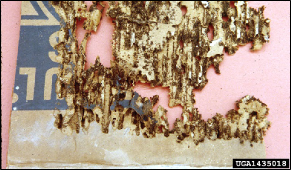
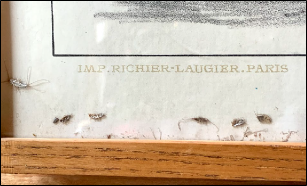
Control
Use a dehumidifier to remove moisture in basements and other damp areas where silverfish are found. Decluttering the house by removing old papers, boxes, books, and clothes will help remove food and hiding places for these insects. Sanitation alone will probably not eliminate an infestation. Use an aerosol insecticide with residual activity to help control these pests. Spray all typical hiding places such as in cracks and crevices, in cupboards, and around water pipes. Diatomaceous earth or boric acid powders can be sprinkled in areas where silverfish or firebrats are seen; follow the directions on the labels of these products. Keep pantry items like flours and grains in storage containers with tight lids to avoid contamination by silverfish and other panty pests.
Revised
Theresa A. Dellinger, January 3, 2023.
Virginia Cooperative Extension materials are available for public use, reprint, or citation without further permission, provided the use includes credit to the author and to Virginia Cooperative Extension, Virginia Tech, and Virginia State University.
Virginia Cooperative Extension is a partnership of Virginia Tech, Virginia State University, the U.S. Department of Agriculture (USDA), and local governments, and is an equal opportunity employer. For the full non-discrimination statement, please visit ext.vt.edu/accessibility.
Publication Date
January 6, 2023



